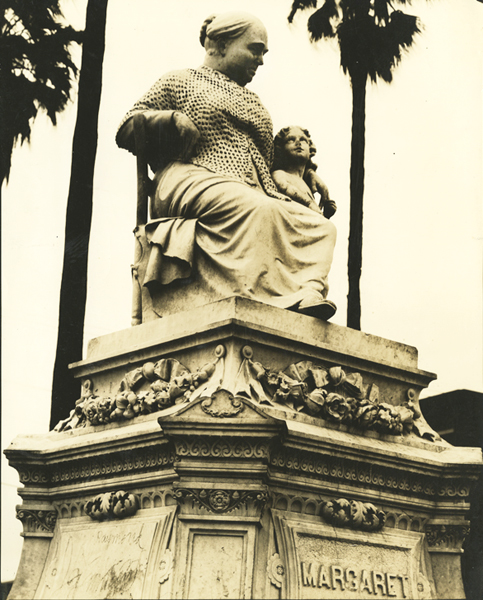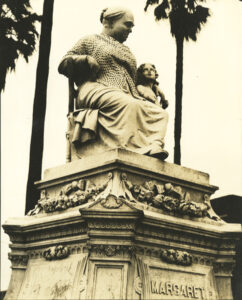Farm Security Administration Photography
The Farm Security Photography project was a Depression-era program that resulted in images which provided a unique glimpse into the lives of working-class Louisianans as they struggled to survive.

Courtesy of State Library of Louisiana
Margaret Gaffney Haughery monument in New Orleans Louisiana. Evans, Walker (Photographer)
As part of President Franklin D. Roosevelt’s New Deal programs, eight of the country’s most accomplished photographers documented rural life in Louisiana. Between 1935 and 1944, Walker Evans, Russell Lee, Marion Post Wolcott, and Ben Shahn, among others, took thousands of images as part of a nationwide effort to identify and alleviate poverty, especially in rural areas. These images provide a unique glimpse into the lives of working-class Louisianans as they struggled to survive during the Great Depression. More broadly, they were part of a project that began as a modest attempt to document southern soil erosion, yet produced perhaps the richest photographic portrait in American history.
The FSA Project
Though popularly associated with the Farm Security Administration (FSA), the Depression-era photography project was actually administered by three different government agencies. From 1935 until 1937, photographers worked for Resettlement Administration. When that agency was abolished, the project was folded into the FSA, where it remained until 1942. From 1942 to 1944, the project continued under the Office of War Information. During the project’s life, twenty-two photographers recorded an estimated 250,000 negatives, primarily of rural poverty in America. Approximately 77,000 of these images, supplemented by some 11,000 others culled from various sources, comprise what is commonly referred to as the “FSA-OWI Classified File,” collected by the Prints and Photographs Division of the Library of Congress.
The project was supervised by Roy E. Stryker, an economics instructor at Columbia University and early advocate of incorporating photography into classroom lectures and publications. Working for his former mentor and FDR advisor Rexford Guy Tugwell, Stryker assembled a remarkable team from the very best American photographers available, among them Arthur Rothstein, Walker Evans, Ben Shahn, Dorothea Lange, Carl Mydans, Russell Lee, Jack Delano, Marion Post Wolcott, Gordon Parks, and John Vachon.
Influenced heavily by Evans and Lange, Stryker’s team epitomized the documentary style. Typically, photographers worked alone on assignments Stryker himself designed, often accompanied by “shooting scripts” he prepared. In this fashion, FSA photographers completed approximately 1,600 “lots” or separate stories all across the country. In the seventy years since its creation, the FSA-OWI Classified File has become the face of the American people during the Great Depression, a collection whose contents contain many of the era’s most searing and best remembered images.
The FSA in Louisiana
Within its first year of operation, Carl Mydans, Arthur Rothstein, Walker Evans, and Ben Shahn all visited Louisiana. Rothstein arrived first, in September 1935, and Mydans followed nine months later. Both men worked in New Orleans and below the city, in Plaquemines Parish. Between these tours, Evans and Shahn, former New York roommates, visited the state, each on his first trip through the South. Shahn shot most of his photographs among migrant fruit pickers in and around Hammond, taking special interest in a family whose bare feet and hardscrabble existence belied the family name, Fortuna, an irony he doubtless relished. Evans quickly followed, having worked his way down the Ohio and the Mississippi River, all the way from Pittsburgh. Moldering plantations on either side of the river clearly fascinated him, Belle Grove especially. He also took an interest, as did all his colleagues, in New Orleans architecture. Indeed, Evans included photographs from both the plantation district and the city for publication in his monumental American Photographs (1938).
Meanwhile, in the summer of 1937, in addition to a trip down Bayou LaFourche, Dorothea Lange focused her efforts in and around Fullerton, Louisiana, southwest of Alexandria. Located in what Lange described as the “cut-over area”—a reference to a nonrenewable harvesting method—Fullerton was a virtual ghost town. Lange’s images emphasize the connection between environmental degradation and social dislocation, a theme central to her classic 1941 study, An American Exodus: A Record of Human Erosion, coauthored by her husband, Paul Taylor.
Roy Styker’s most prolific FSA photographers in Louisiana were Russell Lee and Marion Post Wolcott. Lee first arrived in September 1938, spending the next two months south and west of New Orleans. Aboard the El Rito, a packet steamer bound for the Gulf, he documented life, labor, and leisure among the crew and within small communities along the river. Subsequent excursions took him through the Acadian parishes to St. Martinville, Abbeville, and Opelousas, among others. He documented the salt plant on Jefferson Island, shrimpers in Morgan City, and the sugar cane harvest in Delcambre and Jeanerette before touring the sugar mill in Breaux Bridge. Then, following stops in New Iberia, Raceland, Houma, and Lafayette to record the rice harvest from field to finishing process, it was off to the annual Rice Festival in Crowley.
For versatility, however, no one matched Marion Post Wolcott, whose assignments took her to almost every corner of the state. She photographed Louisiana’s two FSA farm co-ops: Terrebone in Schriever, which was for whites, and its black counterpart, La Delta in Lake Providence. She studied the fur trappers on Delacroix Island, French Quarter architecture, and the Cane River Creoles living near Natchitoches. In late 1941, she recorded the overcrowded conditions among the many thousands who had swarmed into Alexandria seeking defense work.
In June 1943, John Vachon became the last FSA photographer to visit Louisiana, focusing primarily on New Orleans, then a wartime city. He paid particular attention to the Higgins shipyard, whose work proved so crucial to American amphibious campaigns in Europe and the Pacific. By the time Vachon reached New Orleans, the FSA had become part of the Office of Wartime Information, one of several federal agencies organized to explain to the American people the origins, aims, and nature of World War II. The FSA as such had formally ceased operations and closed its offices by the end of 1943.
